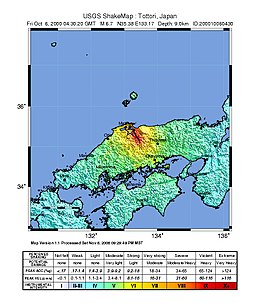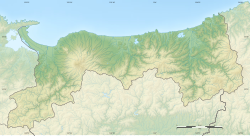 USGS ShakeMap USGS ShakeMap | |
  | |
| UTC time | 2000-10-06 04:30:20 |
|---|---|
| ISC event | 1839998 |
| USGS-ANSS | ComCat |
| Local date | 6 October 2000 (2000-10-06) |
| Local time | 13:30:20 JST (UTC+9) |
| Magnitude | 7.3 MJMA 6.7 Mw |
| Depth | 10 km (6 mi) (USGS) 9 km (6 mi) (JMA) |
| Epicenter | 35°16′N 133°19′E / 35.27°N 133.31°E / 35.27; 133.31 |
| Type | Strike-slip |
| Areas affected | Japan |
| Total damage | $150 million (US) |
| Max. intensity | JMA 6+ (MMI VIII) |
| Landslides | Yes |
| Casualties | 130–182 injuries |
The 2000 Tottori earthquake (Japanese: 鳥取県西部地震) occurred on 6 October 2000, at 13:30:20 local time with a moment magnitude of 6.7 and a maximum Mercalli intensity of VIII (Severe). The epicenter was near Yonago and Matsue. About $150 million in damage was caused (with 104 buildings destroyed) and between 130 and 182 people were injured.
Earthquake
The United States Geological Survey (USGS) reported a moment magnitude of 6.7 and a focal depth of 10 km (6.2 mi) for the earthquake. The Japan Meteorological Agency recorded a magnitude of MJMA 7.3. This was the first time since the seismic intensity classification was revised in 1996 that a JMA maximum seismic intensity of 6+ was recorded.
The focal mechanism was a strike-slip fault type. The earthquake was not caused by the activity of a known fault, but by the activity of an unidentified underground fault. Multiple cracks appeared on the ground surface due to underground displacement.
The aftershock area is distributed along the source fault of the main shock, from Yasugi City in Shimane Prefecture to Hino District in Tottori Prefecture, extending from south-southeast to north-northwest in a length of approximately 30 km and a depth of approximately 15 km.
Prior to the earthquake, swarms of magnitude 5 earthquake activity occurred along the deep extension of the fault in 1989, 1990, and 1997. Trench excavations have determined that the last activity was between 800 and 1200 AD.
Impact
Some people were buried alive from the earthquake, but no one was killed, due to an epicenter was in a mountainous area. between 130 and 182 peoples were injured. The earthquake caused a liquefaction in Sakaiminato City and the collapse and damage of houses in Hino Town, Yonago City, and other areas, making the damage about $150 million.
See also
References
- ^ ISC (2015), ISC-GEM Global Instrumental Earthquake Catalogue (1900–2009), Version 2.0, International Seismological Centre
- ^ PAGER-CAT Earthquake Catalog, Version 2008_06.1, United States Geological Survey, September 4, 2009
- ^ "M 6.7 – 8 km ESE of Matsue, Japan". United States Geological Survey.
- ^ Semmane, Fethi; Cotton, Fabrice; Campillo, Michel (2005). "The 2000 Tottori earthquake: A shallow earthquake with no surface rupture and slip properties controlled by depth". Journal of Geophysical Research: Solid Earth. 110 (B3). Bibcode:2005JGRB..110.3306S. doi:10.1029/2004JB003194.
- "震度データベース検索". Japan Meteorological Agency. Retrieved 16 May 2024.
Further reading
- Ohmi, S.; Watanabe, K.; Shibutani, T.; Hirano, N.; Nakao, S. (2002), "The 2000 Western Tottori Earthquake—Seismic activity revealed by the regional seismic networks—", Earth, Planets and Space, 54 (8): 819–830, Bibcode:2002EP&S...54..819O, doi:10.1186/BF03352075
- Umeda, K.; Asamori, K.; Negi, T.; Kusano, T. (2011), "A large intraplate earthquake triggered by latent magmatism", Journal of Geophysical Research, 116 (B1): B01207, Bibcode:2011JGRB..116.1207U, doi:10.1029/2010JB007963
External links
- The International Seismological Centre has a bibliography and/or authoritative data for this event.
| ← Earthquakes in 2000 → | |
|---|---|
| January | |
| May |
|
| June | |
| July |
|
| September |
|
| October |
|
| November |
|
| December |
|
| † indicates earthquake resulting in at least 30 deaths ‡ indicates the deadliest earthquake of the year | |